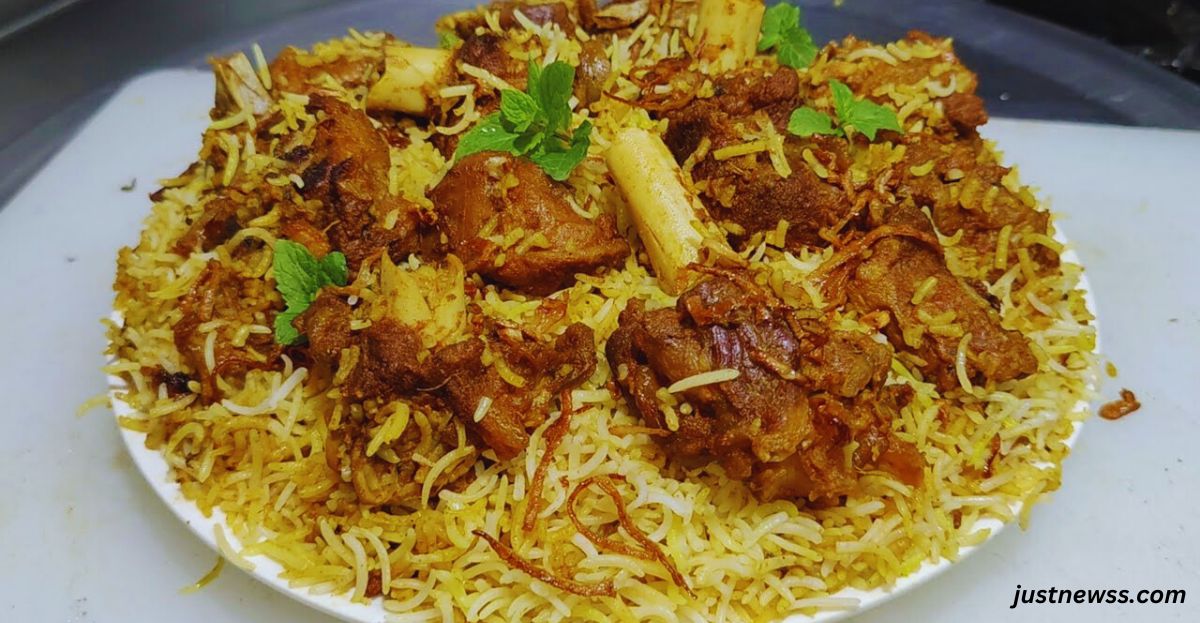Eid is a time of joyous celebrations and sumptuous feasts, and nothing embodies the spirit of this festive occasion better than a delicious plate of mutton biryani. This traditional dish, rich in spices and bursting with flavor, is the perfect centerpiece for your Eid spread. In this detailed recipe, we guide you through every step to prepare an authentic and delectable mutton biryani for 1kg of rice.
Ingredients
For Marinating the Mutton
- 1 kg mutton, cut into medium-sized pieces
- 1 cup yogurt
- 2 tbsp ginger-garlic paste
- 2 tbsp red chili powder
- 1 tsp turmeric powder
- 1 tbsp coriander powder
- 1 tsp garam masala powder
- Salt to taste
- Juice of 1 lemon
For the Rice
- 1 kg Basmati rice
- 4 liters water
- 2 bay leaves
- 4-5 cloves
- 2 cinnamon sticks
- 4-5 green cardamom
- 1 tbsp salt
For the Biryani
- 3 large onions, thinly sliced
- 3 tomatoes, finely chopped
- 2-3 green chilies, slit
- 1 cup fresh coriander leaves, chopped
- 1 cup fresh mint leaves, chopped
- 1 tbsp birista (fried onions)
- 1 cup milk
- A few strands of saffron
- 1/2 cup ghee
- 1/2 cup vegetable oil
Step-by-Step Preparation
Step 1: Marinating the Mutton
To achieve a deeply flavorful biryani, it’s essential to marinate the mutton properly. In a large bowl, mix the mutton pieces with yogurt, ginger-garlic paste, red chili powder, turmeric powder, coriander powder, garam masala powder, salt, and lemon juice. Ensure all the pieces are well-coated with the marinade. Cover the bowl and refrigerate for at least 4 hours, preferably overnight.
See Also:
How To Make Chicken Manchurian
How To Make Chicken Vegetable Macaroni
How To Make Mutton Chops Fry In Restaurant Style
Step 2: Preparing the Rice
Wash the Basmati rice thoroughly until the water runs clear. Soak the rice in water for 30 minutes. In a large pot, bring 4 liters of water to a boil. Add the bay leaves, cloves, cinnamon sticks, green cardamom, and salt. Once the water is boiling, add the soaked rice and cook until it’s 70% done. The grains should be soft on the outside but still firm in the center. Drain the rice and set it aside.
Step 3: Cooking the Mutton
In a heavy-bottomed pan, heat the vegetable oil and ghee. Add the sliced onions and fry until they turn golden brown and crisp. This process, known as birista, adds a sweet and rich flavor to the biryani. Remove half of the fried onions and set them aside for garnishing.
To the remaining onions in the pan, add the marinated mutton and cook on high heat for about 10 minutes. This helps seal in the flavors. Add the chopped tomatoes and green chilies, and cook until the tomatoes become soft and the oil starts to separate from the mixture. Add half of the chopped coriander and mint leaves and cook for another 5 minutes. Ensure the mutton is tender and the masala is thick and rich. If necessary, add a little water and cook until the mutton is done.
Step 4: Layering the Biryani
In a small bowl, warm the milk and add the saffron strands to it. Let it sit for a few minutes to release its color and aroma.
In a large, heavy-bottomed pot, start layering the biryani. Begin with a layer of mutton and masala at the bottom. Cover this with a layer of partially cooked rice. Sprinkle some of the fried onions (birista), remaining chopped coriander and mint leaves, and a few tablespoons of saffron-infused milk. Repeat these layers until all the mutton and rice are used up, finishing with a layer of rice on top. Pour any remaining saffron milk over the top layer and dot with ghee.
Step 5: Dum Cooking the Biryani
To achieve the perfect biryani, the dish needs to be cooked on dum, a slow-cooking method where steam cooks the layers to perfection. Seal the pot with a tight-fitting lid. You can also place a dough seal around the lid to ensure no steam escapes.
Place the pot on a tawa (griddle) and cook on low heat for about 30-40 minutes. This allows the flavors to meld together beautifully and the rice to absorb the aromatic spices and the richness of the mutton.
Step 6: Serving the Biryani
Once the biryani is done, let it rest for 10 minutes before opening the lid. This helps the steam settle and makes the rice fluffy and aromatic. Gently fluff up the rice with a fork, ensuring not to break the grains.
Serve the mutton biryani hot, garnished with the reserved fried onions (birista). Accompany it with a side of raita (yogurt sauce) or a simple cucumber salad to balance the rich and spicy flavors of the biryani.
Tips for the Perfect Biryani
- Quality of Ingredients: Always use fresh and high-quality ingredients. Good Basmati rice, fresh spices, and tender mutton make a significant difference.
- Marination Time: Allow enough time for the mutton to marinate. This step is crucial for tender and flavorful meat.
- Layering: Be patient with the layering process. Even and careful layering ensures each bite is flavorful.
- Dum Cooking: The dum process is vital for an authentic biryani. Ensure the pot is well-sealed to trap the steam and cook the biryani perfectly.
Enjoy your Eid celebration with this delightful mutton biryani, a dish that truly represents the richness and diversity of Indian cuisine. Its intricate flavors and aromatic spices will make your feast memorable and cherished.
FAQs about Eid Special Mutton Biryani
1. How long should I marinate the mutton for the best results?
For the best flavor and tenderness, marinate the mutton for at least 4 hours. However, marinating it overnight in the refrigerator allows the spices to penetrate deeply, resulting in a more flavorful and tender mutton biryani.
2. Can I use regular rice instead of Basmati rice for this biryani recipe?
While you can use regular rice, Basmati rice is highly recommended for biryani due to its long, slender grains and aromatic qualities. Basmati rice absorbs flavors well and remains fluffy, which is essential for the perfect biryani texture.
3. What is the purpose of the dum cooking method in biryani preparation?
The dum cooking method involves sealing the pot and cooking on low heat, allowing the steam to cook the layers gently. This method ensures that the flavors meld together beautifully, the rice absorbs the spices and aromas, and the mutton becomes tender and juicy. It is crucial for achieving an authentic and flavorful biryani.
4. How can I ensure my rice doesn’t overcook or become mushy in the biryani?
To prevent the rice from overcooking or becoming mushy, cook the rice until it is 70% done before layering it with the mutton. The grains should be soft on the outside but still firm in the center. This ensures that the rice finishes cooking perfectly during the dum process, absorbing the flavors without becoming too soft.







